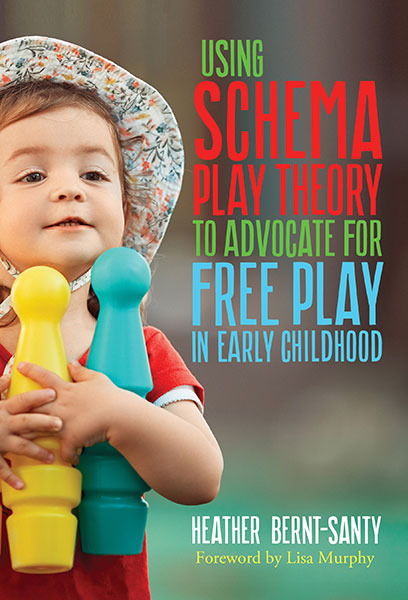Professors: Request an Exam Copy
Print copies available for US orders only. For orders outside the US, see our international distributors.
Foreword by: Lisa Murphy
Publication Date: November 21, 2025
Pages: 144

The host of the internationally popular early childhood podcast “That Early Childhood Nerd” provides a framework for understanding the importance of free play.
Free play is disappearing from the lives of too many young children, leaving them vulnerable to negative effects on their physical and mental health, social and emotional growth, and academic development. Heather Bernt-Santy makes a powerful, research-based case for taking children’s right to play seriously. She helps readers understand and resist the pressures and cultural influences that set up barriers to free play. Early care and education practitioners will learn how to see, support, and interpret play to those who are skeptical or unsure of play’s benefits. Each chapter includes a scenario that offers readers the opportunity to closely observe children’s play through the lens of Chris Athey’s schema play theory. This framework will help educators advocate for play by identifying its contributions to children’s overall development.
Book Features:
Heather Bernt-Santy is a speaker, education consultant, writer, professor, and host of the internationally popular early childhood podcast “That Early Childhood Nerd.”
"Heather engages readers' curiosity to come closer and fall down the rabbit hole of schema play so as to understand the important role it plays in advocating for free play in early childhood."
— From the Foreword by Lisa Murphy, CEO and founder, Ooey Gooey, Inc.
"A brilliant and powerful analysis of how and why we must base childhood education upon the human behavior that young people yearn for and love to do most, the thing they are biologically and emotionally engineered to do, and the activity we are taking away from them—play, in all its magnificent and life-changing forms."
—William Doyle, coauthor, Let the Children Play
“What a gift it is to catch a glimpse of Jaden, Ann, Davina and Max at play. These children (and others) have stories, and Heather Bernt-Santy is helping tell them, in new ways, so that we can hear the schema of their play. This book flows from disrupting what we think we know of schema, playing next into a reordering of how to ‘interpret the language of childhood play,’ and on to a new advocacy for free play.”
—Josh Thompson, professor of early childhood care and education, East Texas A&M University
“During uncertain times, when young children’s opportunities for free play are increasingly under threat, Heather Bernt-Santy brings fresh insights into the value of free play and why it is worth defending. Brimming with practical examples, this accessible book shows how looking through a schema play lens can make learning visible.”
—Alison Clark, professor of early childhood education, University of South-Eastern Norway
“Using Schema Play Theory to Advocate for Free Play in Early Childhood is an engaging and insightful guide that transforms the way we see children’s actions—turning what might look like ‘misbehavior’ into evidence of deep learning—and equips educators and families with powerful tools to defend every child’s right to play. Heather Bernt-Santy blends research, practical examples, and advocacy strategies into a must-read for anyone committed to honoring childhood curiosity.
—Barrie Olson, chief academic officer, Literacy Design Collaborative
“Heather approaches advocating for play cleverly and intelligently. Connecting to schema theory offers early childhood professionals and play advocates a powerful avenue to overcome the barriers and challenges that interfere with the implementation of play as the main vehicle for young children's learning. This is a must-read book!”
—Miriam Beloglovsky, founder, Playful Transformation, LLC
Contents
Foreword Lisa Murphy xi
Acknowledgments xiii
1. What Is Schema Play Theory? 1
Jean Piaget 2
Chris Athey 2
Using Schema Play Theory to Advocate for Free Play 7
It’s Not All in Our Heads 9
2. Free Play Pedagogy: Benefits and Barriers 11
Benefits of Free Play Pedagogy in Early Childhood 12
Barriers to Free Play Pedagogy in Early Childhood 21
3. The Transforming Schema 27
What Is a Transforming Schema? 27
Transporting Story: Ann and Miguel 27
Transforming Story: Jerrold 32
Supporting the Transforming Schema in Your Play Space 36
4. The Trajectory Schema 39
What Is a Trajectory Schema? 39
Trajectory Story: Davina 40
Trajectory Story: Jaden 43
Supporting the Trajectory Schema in Your Play Space 47
5. The Transporting Schema 49
What Is a Transporting Schema? 49
Transporting Story: Bert 49
Transporting Story: Zahra 54
Supporting the Transporting Schema in Your Play Space 58
6. The Rotation and Circularity Schema 61
What Is a Rotation and Circularity Schema? 61
Rotation and Circularity Story: Elijah 62
Rotation and Circularity Story: Marta 66
Supporting the Rotation and Circularity Schema in Your Play Space 70
7. The Enclosing and Enveloping Schema 71
What Is an Enclosing and Enveloping Schema? 71
Enclosing and Enveloping Story: George 72
Enclosing and Enveloping Story: Warren 76
Supporting the Enclosing and Enveloping Schema in Your Play Space 80
8. The Connecting and Disconnecting Schema 81
What Is a Connecting and Disconnecting Schema? 81
Connecting and Disconnecting Story: Millie 82
Connecting and Disconnecting Story: Joan and Mishika 86
Supporting the Connecting and Disconnecting Schema in Your Play Space 90
9. The Positioning and Ordering Schema 93
What Is a Positioning and Ordering Schema? 93
Positioning and Ordering Story: Caleb 93
Positioning and Ordering Story: Max 98
Supporting the Positioning and Ordering Schema in Your Play Space 103
10. The Orientation and Perspective Schema 105
What Is an Orientation and Perspective Schema? 105
Orientation and Perspective Story: Alejandro 105
Orientation and Perspective Story: Link 110
Supporting the Orientation and Perspective Schema in Your Play Space 114
Conclusion 115
References 117
Index 121
About the Author 127
Professors: Request an Exam Copy
Print copies available for US orders only. For orders outside the US, see our international distributors.